A national center of excellence at the University of Hawaiʻi at Mānoa is doing much more than groundbreaking biomedical research. The Integrative Center for Environmental Microbiomes and Human Health (ICEMHH) is building infrastructure and capacity to better Hawaiʻi’s human, environmental and economic health.
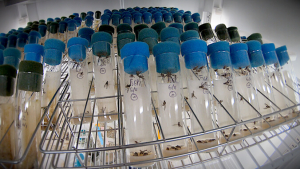
“We’re designated a center of excellence for microbiome research. It means that people are really looking to Hawaiʻi to make the next vanguard discoveries in this field,” said Principal Investigator Anthony Amend, a professor with the Pacific Biosciences Research Center. “We’re making incredible discoveries about microbiomes—symbiotic microbes, things like bacteria, fungi, viruses that are inside living hosts, including us—and this underpins life on Earth as we know it.”
Utilizing two grants from the National Institutes of Health Centers of Biomedical Research Excellence (COBRE) totaling more than $21 million, ICEMHH has also developed three state-of-the-art “cores”—an insectary, a microbial genomics laboratory and a microscopy imaging center—for cross-disciplinary public impact research beyond how microbiomes impact human health.
Fruit flies, mosquitos, related diseases
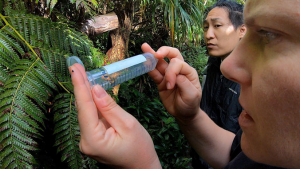
The Insectary for Scientific Training and Advances in Research or InSTAR promotes research on insect microbiomes (the microorganisms of a particular site or habitat) and advanced research in medical entomology (study of insects). It offers insect-rearing equipment and services, a collaborative lab and rearing space, insect containment, and other training and insect-management services.
Amend said, “Users of this core include some of our researchers here at the university and state agencies that are trying to understand disease—how it spreads in our state and how to mitigate those risks.”
Some of those mosquito-carried diseases include zika, dengue fever and malaria.
DNA sequencing, genetic analysis
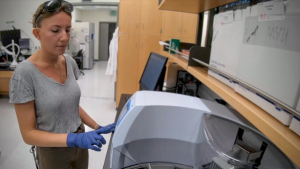
The Microbial Genomics and Analytical Laboratory or MGAL houses the necessary instrumentation to provide a wide variety of services, such as high-throughput DNA/RNA extractions (to examine molecules that make up our genomes, and to generate “barcodes” for identifying microbes), amplicon library preparation (a highly targeted approach that enables researchers to analyze genetic variation in specific genomic regions), natural product and small molecule analysis, and culturing and storage of microbial strains.
“What this core does is enable somebody to come in with a sample of an animal or a soil sample or any sort of environmental sample. They can bring it to the core, drop it off and in a matter of weeks come out with a list and a figure of all of the microbes and their genomes that are within that sample,” Amend said. “This has really revolutionized our ability to determine ecological processes that are happening on microscales.”
Photons, electrons, more in high resolution
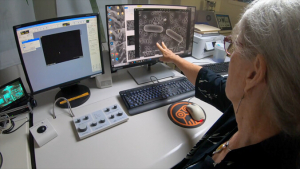
The Microscopy Imaging Center for Research through Observation or MICRO provides researchers with state-of-the-art instrumentation, training and services for high-resolution scanning electron microscopy, transmission electron microscopy, optical, fluorescence, laser scanning confocal microscopy and image analysis.
“You can look at photons. You can look at electrons—all these different tools to study microbes in their host environments,” Amend said.
The three research cores have already attracted a wide variety of users.
“We host researchers from all over the world, who come to learn about microbes, to use our facilities and to take that knowledge back to their countries, to develop their own expertise,” Amend said.
At the other end of the spectrum, there was the gentleman who walked in off the street and wanted to know which microbes were in his sourdough starter—which he thought made the most delicious bread and helped to keep his skin clear. In a matter of weeks the MGAL facility had a list of all the beneficial bacteria and yeasts contained in that flour and water sample.
Sustaining excellence
COBRE grants are awarded in three sequential five-year phases.
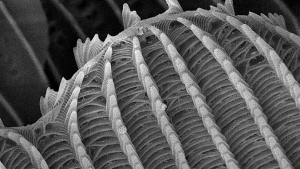
- Phase 1 awards build capacity in an area of biomedical research through the establishment of a center of excellence that helps develop a critical mass of investigators who are able to compete effectively for independent research funding and improve infrastructure in the center’s research area. Researchers in UH’s Phase 1 $10.4-million grant generated almost $22 million in extramural funding.
- Phase 2 awards strengthen successful COBRE Phase 1 centers through continued development of investigators to compete effectively for independent research, pilot project funding and further improvements to research infrastructure at the institution. Improving the three research cores is a focus of UH’s $10.7-million Phase 2 grant.
- Phase 3 awards provide support for maintaining research cores developed during Phases 1 and 2 to sustain a collaborative, multidisciplinary research environment with pilot project programs, mentoring and training components.
UH will be applying for a Phase 3 award to sustain its world-class microbiome research and three research cores. According to Amend, the center is accelerating many kinds of projects that people care about.
He said, “We hope that by launching this center of excellence and by maintaining these three cores, it puts Hawaiʻi at the forefront of this research where we can make these discoveries to promote our own livelihoods, economic opportunities and sustainability going into the future.”
—by Kelli Abe Trifonovitch

